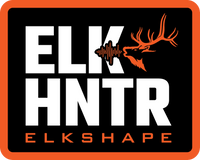EHM Issue 1 Published WesternHunter on May 23, 2012
“Dude, I need a breather,” I shamefully murmured to my hunting partner. I was struggling to hike the last load of loose meat and bull bone. Soggy feet, busted boots, and a Badlands Ox clung to my blood and sweat-soiled shirt. My water bottle was empty, we were ten miles from the nearest road, this was the fourth elk I had packed out in the last ten days, and it just about broke me. I was whittled down to five-step intervals followed by a long, bent-over rest. How could a guy who’s in the best shape of his life succumb to complete exhaustion? Maybe it was just between the ears, but I was running out of gas fast. If I’m struggling to pack this elk out, how does someone do it out of shape? Truth is they probably don’t. Right then and there, I promised myself that the next elk hunting article I wrote would not encourage, but demand that all elk hunters train for the mountains.
I coach fitness for a career. My uniform is sweats and a t-shirt, and I workout between client appointments every day, prescribing over 1,000 workouts a year for clients… so why was I failing to walk the walk? Barely 30 years old, coming off the best off-season conditioning program, I stood there in the steep huckleberry brush of Idaho baffled at my empty gas tank. Maybe I’m killing elk too deep in the backcountry. Maybe I need to incorporate more rest days when I’m hunting (that will never happen). The mind can really start to run wild with negative thoughts when you’re at your wit’s end. This marked my 24th day in a row of backcountry bowhunting with ample success, yet I was deteriorating fast. My 2011 elk hunting season consisted of 33 days between the end of August and all of September, and I can tell you that to be in shape for the rigors of DIY elk hunting requires a tremendous amount of physical and mental prowess. This is significantly more important than top-notch gear and prime hunting ground. A bull elk can weigh over 800 lbs. on the hoof, and can yield a few hundred pounds of perfect protein to feed your household. I’m a meat hunter first and foremost, so preserving elk meat in the mountains is my highest priority. If you hunt with horses, bikes, ATVs, or near a road, there’s still no guarantee as to where that bull will take his last breath. Compound that with warm temperatures, flies, predators, and limited help, and you can’t tell me that fitness isn’t a prerequisite! I’ve killed many bulls with a bow in the last few years and not one died on or near a road or trail.
To prepare for the specificity of this grueling and daunting chore, I’ve trained with heavy packs, ran with a vest, cross-trained, and meticulously calculated my food intake. My gear room has shuffled through the industry’s finest, lightest, and most durable gear in hopes of evolving into the perfect setup for September. All my ducks were in a row, yet I was seconds away from bonking on a hunt I dreamed about all year. Don’t let this happen to you! You want to be an elk killer? Well, you better make darn sure you’re fit as a pack mule for when your dreams come true, or it may quickly become a nightmare. Here’s my first list of Dos and Don’ts as it pertains to being in elk hunting and elk harvesting shape.
The Dos: Do hydrate. I go through a tub of Wilderness Athlete’s Hydrate and Recover every September. It adds miles to your boots, tastes great, and makes fluid consumption happen. Do remember to eat. The action can be good all morning long and oftentimes we forget to eat or don’t take the time. Never skip breakfast; make sure there’s something good going into your body in the morning besides just coffee. I slam a protein bar and consume handfuls of trail mix to keep fueled. Do prepare for a kill. We always leave pack frames in the truck, at the trailhead, or hike them in. My Badlands 2200 day pack is always good for the first hindquarter, but it’s nice to grab a pack frame for the second load when back at the truck.
Now that the Dos are spelled out, let’s cover a couple of Don’ts: Don’t show up fat. Extra weight to lug around is not only a hindrance, but also can handicap your ability to flank elk herds, negotiate rough terrain, and put up with the daily grind. Don’t “hunt your way into shape”. I’ve actually heard peers tell me this was part of their plan. This is not the right program! Don’t take time off when the season comes to an end. If you dropped a few pounds on your hunt and hiked all over, you probably ought to let the start of a beautiful thing continue. Don’t hibernate. Winter can be long and physical activity can take a backseat to the holidays, reduced daylight, and cold weather. Elk don’t take the winter off; you shouldn’t either. Don’t lose meat. Both of my bulls killed in 2011 died during Indian summer conditions. Always pack game bags, a sharp knife, and parachute cord in your pack. Gutless method is my favorite, and getting that hide off is essential. Find the nearest creek or north-facing timber to hang your meat and be prepared to take some with you on your first trip out.

